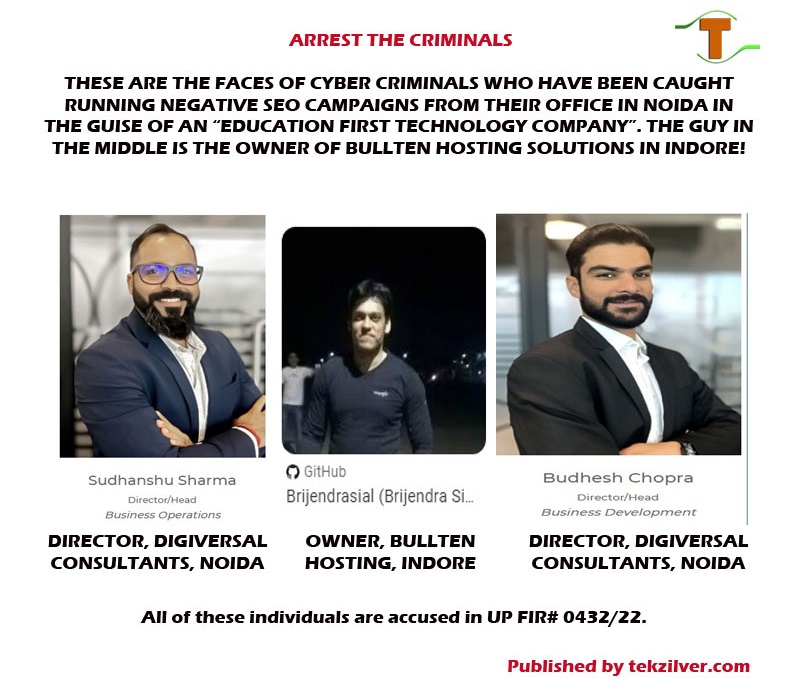PROTECT YOUR BUSINESS FROM NEGATIVE SEO ATTACKS
With Negative SEO (or just n-SEO, in short), you can destroy your business competitors, rivals, enemies or anybody you don't like by hacking and infecting their websites with malware, stealing their hosting resources, hot-linking to their images from spammy websites, pointing backlinks to their websites from spammy/porn/drugs related websites, url manipulation, email bombing, http flooding, phishing, scanning, probing, DDOS and basically ruining their business and reputation. Any organization can be the target of a Negative SEO attack, irrespective of the size of the organization.
Our decision to publish personally identifiable details of the cyber criminals is in line with our policy to publicly name and shame the cyber criminals who attacked our websites starting Nov 2021. There are two active FIRs (no:432/22 & 15/23) pending against these individuals.
Negative SEO service is a reality today both in India and in other countries. We caught a gang in India (check the images in this article) who are involved in running negative SEO attacks against t a.k.a N. N. Sudhanshu heir competitors and other businesses. Their names are, from left to right, Sudhansu Sharma (Phone:+91 9540281586), Brijendra Sial (Phone:+91 9752255794) and Budhesh Chopra (Phone: +91 9891264697).
Sudhanshu Sharma (alias N.N. Sudhanshu) and Budhesh Chopra are the promoters of Digiversal Consultants in Noida, in the north Indian state of Uttar Pradesh, near the National Capital Region (NCR).
Budhesh Chopra also runs SSSI Online Tutoring Service, Noida (sssi.in) (Phone: +91 7428739407).
Sudhanshu Sharma also runs Tatvik Ayurveda (tatvik.shop), where he calls himself "N.N. Sudhanhsu and the co-founder" of the criminal enterprise. (Phone: +91 98216 39129, 95602 66754, 7827342840)
Brijendra Sial owns and runs Bullten Web Hosting Solutions in Indore (bullten.com, Phone: +91 9752255794).
This gang is engaged in scamming innocent citizens through various websites they own, such as Writoversal.com, Digiversal.in, Tutorversal.com, ExpertGrad.com and many more. Click here to read about what these criminals did to our websites in November 2021. Call the police right away if they contact you and try to offer their scam services.
The business model of these guys defines carrying out cyber attacks on their competitors in order to promote their own businesses. Brijendra Sial, who runs Bullten Web Hosting Solutions, Indore uses his own hosting infrastructure to run these attacks. Once a crime is committed, they hop on to a different server in order to hide their tracks, thanks to Brijendra Sial. These guys use Cloudflare and a number of VPS (virtual private servers) from well-known providers such as AWS (Amazon Web Services), Digital Ocean, MS Azure and others. Tekzilver has tracked down every aspect of their criminal operations and the sources from where they procure their malicious codes. We cannot discuss more on it in this article as the matter is currently under investigation by the UP cyber police.
This article is written for public safety and awareness, both about the nature of the crime, as well as the criminals who carry out such attacks, such as whose names we have mentioned above. It is important for all of us to accquire sufficient knowledge about the topic and be better prepared to manage the situation, if the need arises. The topics discussed in this article are listed below. Click on any of the links to directly jump to that topic. Click on the back-button on your browser to return.
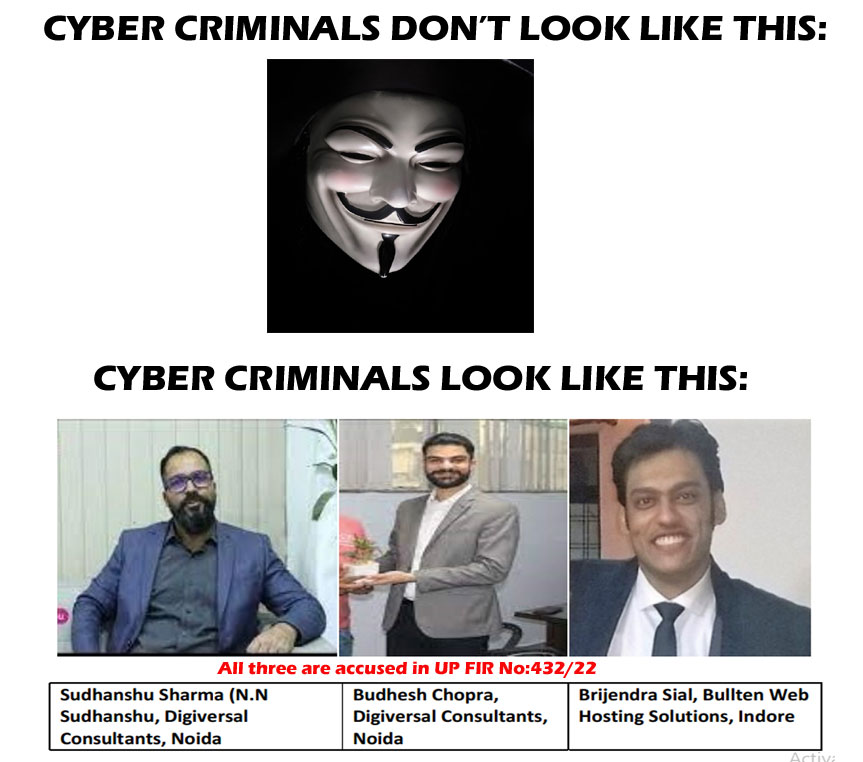
What is SEO?
The term SEO simply stands for "Search Engine Optimization". This is a process by which you make changes to the pages in your website(s) so that they rank better on Google or any other search engine, for that matter. For normal people like you and me, SEO simply means that. But there are others who think beyond the normal, with criminal intent. These individuals look for ways and means to deviate a perfectly legitimate concept for criminal use. That is why SEO became classified into different categories such as White Hat SEO, Black Hat SEO and Negative SEO.
What is WHITE-HAT SEO?
As mentioned earlier, white-hat SEO is what normal people do. White-Hat SEO practitioners follow Google's SEO guidelines so that their web pages ranks higher in the SERPs. In other words, White-Hat SEO requires us to follow all the requirements laid out by Google and probably some other search engines. But since Google has over 92% of the share of the online search market, we will just consider Google. But that is not to ignore the importance of other search engines such as Bing, Yahoo, Yandex, Baidu etc. Simply put, in White-Hat SEO, you play by the rules.
In White-Hat SEO, we do a bunch of things such as the following:
We will not delve too deep into White-Hat SEO because the focus of this article is Negative SEO. But, we will look at each of these activies briefly and move on to the next topic, Black Hat SEO.
What is TECHNICAL SEO?
In Technical SEO, we take care of the technical requirements of the search engines. We make sure that there is a properly functioning robots.txt file and a sitemap.xml file. We aslo make sure that the web-pages are mobile friendly and all the pages are protected by HTTPS. If we are using multiple languages or targeting multiple geographies (countries), then we have to make sure that the HREFLANG directive is properly appliled. We also make sure that each page has a properly declared CANONICAL meta tag. Make sure Google analytics (GA) and Google Search Console (GSE) are inserted in each page. We would also suggest you have your website registered and verified with Bing Webmaster Tools and Yandex Webmaster Tools as well.
What is ON-PAGE SEO?
In On-Page SEO, as the name suggests, we look at all factors in a web-page that can be optimized so that the page ranks high in Google's SERPs. (By the way, SERP stands for Search Engine Results Page). Some of the imprtant things we will look for in On-Page SEO would be making sure we have the right primary and secondary keywords in all the right places, such as H1, H2 & H3 tags. Make sure that the title and description have the primary keyword and start with the primary key word. Also make sure the secondary keyword is also mientioned in both the tags. Take care to maintain the recommended character length for both these tags.
Make sure the images are optimized and named appropriately. Add ALT TAGS and TITLEs for each image. Having a prominent CTA (Call To Action) is necessary in each page, especially if you are expecting yor website's visitors do do something, such as buying something from your website or signing up for some service. A CTA button is generally used for this purpose. A number of other options can be used too, but take to make sure it does not become too intrusive and affect the visitors' User Experience on your website. Another important factor to consider is the use of LSI (Latent Semantic Indexing) keywords and Long Tail keywords.
Simply put, just use synomyms of your primary and secondary keywords and long tail versions of the same. Don't fall for the tempataion for keyword-stuffing. Check the URL of the webpages and name it after your primary keyword. And oh, yes, don't forget to optimize your images so that they don't become a drag on your webpages when they load. Last but not the least, there should be sufficient content on the page, we would say at least a minimum of 1200 to 1500. Make sure the page is properly structured and divided into sections. Use short sentences and language that is easy to understand. Internal links are equally important.
What is Off-PAGE SEO?
As the name suggests, Off-Page SEO is everything we would do outside of the web-pages to make sure our website ranks high in the Google SERPs. In Off-Page SEO, everything you do, is done with one intention only, and that is to build as many backlinks to your website as possible. That is why, Off-Page SEO is also simply known as LinkBuilding. Guest Posts, Forum Posts, Submission to Directories, Content Marketing, Video Marketing, PDF submissions, PPT Submissions, Business Profile Creation are some of the things you would do here.
Off-Page SEO is an ongoing process and the more backlinks you build to your website the better chances you will have to rank it higher on Google. But, again, there is a flipside to this - make sure you build backlinks to your website from the relevant niche and from websites with high DA (Domain Authority) and PA (Page Authority). Building backlinks from low-quality websites, porn-websites, gambling websites, drug-selling websites is a sure-shot way to make sure your website never ranks any where on Google, or even worse, gets thrown out of Google altogether.
WHAT IS GREY-HAT SEO?
Between White-Hat SEO and Black-Hat SEO, there is a "grey area" which SEO professionals like to call Grey-Hat SEO. Remember our initial definition of White-Hat and Black-Hat SEO? So, in White-Hat SEO, we play by the rules of Google, a.k.a Google Webmaster Guidelines. This has now been renamed as Google Search Essentials. Stricly by the rules. Whereas, in Black-Hat SEO, it's just the opposite, where we don't care for Google's rules but try to do things we are not supposed to do, or even allowed to do, so that we can rank our websites higher on Google's SERPs. Now, Grey-Hat SEO comes somewhere in-between these two extremes.
Some of the activities that come under Grey-Hat SEO are buying backlinks, paying for good reviews, purchasing expired domains, also known as "Domain Grabbing", using Clickbait, publishing low-quality, irrelavant content, keyword stuffing etc. Some SEO professionals like to dabble in Grey-Hat SEO inspite of the risks it carries.
WHAT IS BLACK-HAT SEO?
After White-Hat SEO and Grey-Hat SEO is, we now come to the next topic, What is Black-Hat SEO? Well, Black-Hat SEO is everything that Google does not want you to do to rank your website on Google's SERPs.
Black-Hat SEO activities include Doorway Pages, Cloaking (that is, showing different pages to humans and bots), Keyword Stuffing, Setting Font-size to zero, Setting font-color the same as background color, URL Redirection, Negative SEO, PBNs (Private Blogging Networks) or Link Farms, Content Spinning, Malicious Content in Pages(such as adding malware in web pages). Content Duplication. Hidden Content, Hidden Links (such as by using the "display:none" style tag (check the image below), Use of Single Character Hyperlinks and Comment Spam. Now, doing any of these could easily get your website banned by Google because all of these go against the Google Webmaster Guidelines. We will not go in-dept into these topics because the main topic for this article is Negative SEO.

Note: The image above shows the hidden links placed by a gang of cyber criminals in Noida, Sudhanshu Sharma, Brijendra Sial & Budhesh Chopra) to their own website called "AssignmentsHelpLite.com" after hacking other websites. Sudhanshu Sharma & Budhesh Chopra are owners of Digiversal.in in Noida, whereas Brijendra Sial is their hosting services prover & owner of Bullten Hosting Solutions in Indore. This gang runs negative SEO attacks against other companies. Budhesh Chopra is also owner of SSSI Online Tutoring Service, which is also located in Noida, India.
WHERE TO FIND TOOLS FOR BLACK-HAT & NEGATIVE SEO?
The world-wide-web is such a vast place and for someone who's seriously searching, such tools are bound to show up sooner or later. Of course, the dark web is a known source of such tools, services and service providers. Exercise extreme caution while venturing out into these places because out there, there are no boundaries of ethics, rules and regulations. It would be unwise to expect any. Another well-known place is GitHub. Just google the tool you are looking for and end your search term with "GIT" and you will be surprised at the number of options that show up. You can also find all kinds of malware from known malware databases and malware repositories. Here's another malware repository. All of this is just a Google search away.
MALWARE ANALYSIS TOOLS & SANDBOXES
On the other hand, if you have been infected by a malware, you can get the infected file analysed using malware analysis tools online and malware sandboxes. Many of these tools are freely available online. Just search for it. Virustotal is a well known malware analysis tool that lets you analysis malware files, IPs and URLs.
WHAT IS NEGATIVE SEO?
Negative SEO is anything you would do to harm the website of others, such as your rivals or competitors. While even seasoned SEO professionals stay away from Negative SEO, it is used mostly by criminals to earn a quick buck or destroy competition. Negative SEO is done using a number of tools which are freely available online for White-Hat and Black-Hat SEO activities. In most cases, victims of Negative SEO may not even know that they have been hit by a Negative SEO attack, and will be struggling to restore their website and their business. But trained professionals, such as in Tekzilver, can easily identify a Negative-SEO attack and move quickly to mitigate the same.
Negative SEO consists of the following activities:
Backlink Spamming: Generating a large number of low-quality, spammy backlinks to a target website. These links often come from irrelevant or low-ranking websites and can be created using automated tools or by hiring cheap link-building services.
Link Farms: Creating or using networks of websites that exist solely for the purpose of generating backlinks. These link farms typically have low-quality content and serve no real value to users.
Content Scraping: Copying and republishing a competitor's content on other websites without permission. This practice can lead to duplicate content issues and potential penalties for the original content creator.
Fake Reviews: Posting false negative reviews about a competitor's products or services on review sites, forums, or social media platforms. This tactic aims to damage the reputation of the target website or business. The image below only shows there is still a market for this kind of stuff.
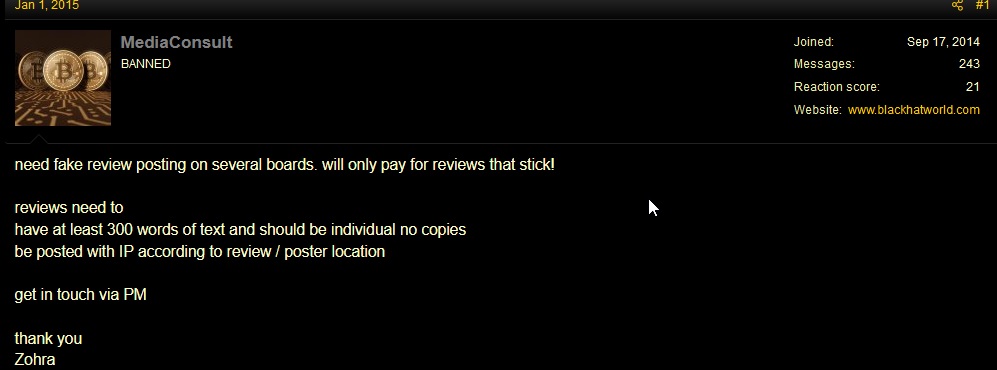
Hacking: Attempting to gain unauthorized access to a competitor's website with the intention of causing harm, deleting content, or injecting malicious code.
Distributed Denial of Service (DDoS) Attacks: Overloading a competitor's website with an overwhelming amount of traffic, causing it to become unresponsive or crash. DDoS attacks aim to disrupt the target website's availability and user experience.
Content Spamming: Generating and publishing low-quality, keyword-stuffed content on various platforms, including blogs, forums, or comment sections, in an attempt to manipulate search engine rankings.
HotLinking: Basically this means stealing bandwidth of other websites & using somebody else's image without their permission. Criminals create links to artefacts on your website, mostly images and publish them in multiple spam websites instead of taking permission from the original website owner and uploading the image on their own website. Everytime somebody opens the image from the spam website, it utilizes the bandwidth of the original website. Publishing other people's images could also lead to legal penalties.
Adding Query Strings to URLs: Cyber criminals also try to add parameters or query strings to target URLs so that the pages never load. For example, lets say you have a page called https://example.com/page1.html. The criminals will try to append a query string to the URL so that it would look like this: https://example.com/page1.html/?query=something.
Engaging in negative SEO practices is unethical and can result in severe penalties for those involved. Search engines like Google actively work to identify and penalize websites involved in such activities. It is recommended to focus on ethical SEO techniques and building a strong online presence based on quality content, user experience, and legitimate marketing strategies.
Apart from Google's penalties, engaging in Negative-SEO tactics can even be illegal and against the law and could land you in jail.
TOOLS USED FOR NEGATIVE SEO
A number of tools can be used for Negative SEO but the thing about these Negative-SEO tools is that, they are not inherently "Negative". In fact, there are many tools that have perfectly legitimate White-Hat SEO uses but are unethically used for Negative-SEO attacks.
Link Building Automation Tools: There are various tools available, such as GSA Search Engine Ranker, ScrapeBox, or XRumer, that automate the process of creating and distributing backlinks. While these tools can be used for legitimate link building, they can also be abused for spamming and creating manipulative backlink campaigns.
Content Scraping Tools: Tools like ScrapeBox and others automate the process of scraping content from other websites. While content scraping itself is unethical, these tools can aid in the automation of such practices.
Negative Review Posting Tools: These are software or services online that claim to post negative reviews or feedback on review platforms or social media. These tools enable the mass creation and submission of false negative reviews.
Bot Networks and DDoS Tools: Tools and services that offer bot networks or distributed denial of service (DDoS) capabilities are not only unethical but also illegal in many jurisdictions. These tools can be used to overwhelm a website with traffic or conduct other malicious activities.
LIST OF TOOLS USED FOR BLACK-HAT & NEGATIVE SEO
NEGATIVE SEO. HOW DOES IT WORK?
Like we said before, many of the tools we mentioned above are perfectly built to carry out a specific SEO function. But these are also unethically misused by criminals to carry out Negative-SEO attacks against unsuspecting businesses. Let's take a look at an example of how this can be misused.
Let's take a look at an automatic indexer tool.
An automatic indexer is a tool or software that is used to generate a large number of low-quality backlinks to a target website automatically and quickly. These tools aim to manipulate search engine rankings by artificially inflating the number of backlinks pointing to a website. A Black-Hat SEO guy would use this tool to accquire as many backlinks to his website as possible, whereas, a criminal involved in Negative-SEO could use the same tool to create as many poor quality, spammy, porn, drug related, backlinks to a competitor's website so that it slides down the SERP ranks. We were hit by such a an attack, but we will not be showing the specifics for privacy.
Another example of Negative SEO attack: Let's take a tool that is a "Website Submitter". In other words, this is a tool that would submit your website to thousands of search engines and directories. So, one can use this to submit your own website's URL's or use this to submit spammy, incorrect, or redirected URLs that will throw a 404 error on Google, making Google think the website is spammy and downgrading it on the SERPs or even worse, knocking it out of the SERPs altogether. Take a look at the screenshot below. This is what happened when we were hit by a Negative-SEO attack, by the criminals whose pictures are shown in the image at the beginning of this article.
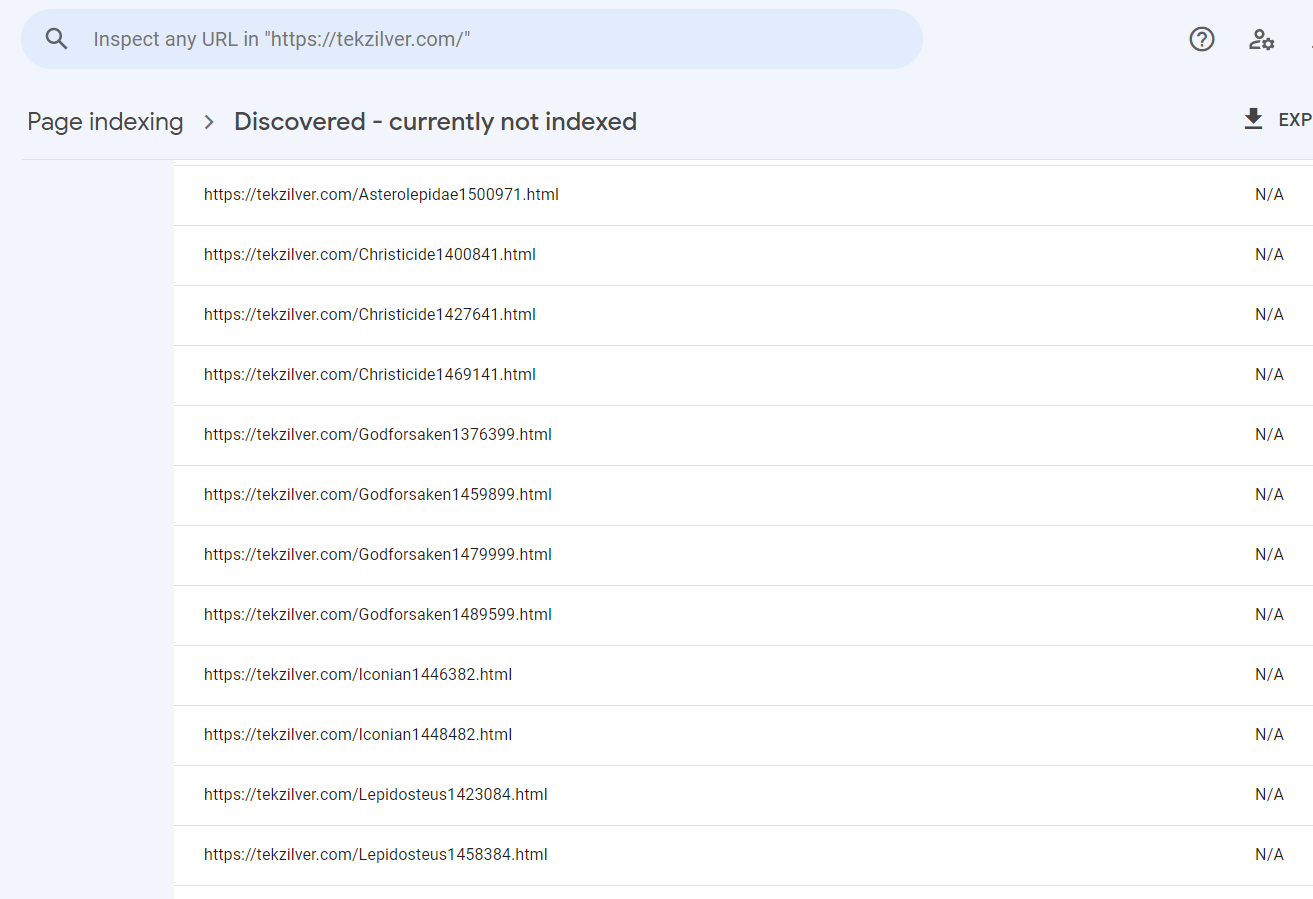
To make it even more effective, add some parameters to the target website's legitimate URLs so that it keeps redirecting endlessly till finally throwing a 404 error and the page never loads. Like, for example, what happened to us as shown in the image below:

HOW TO LOWER A WEBSITE'S RANKING ON GOOGLE SERPS USING NEGATIVE SEO?
This is going to be interesting. Fact is, we are updating this article with some more things you can do to lower a website's ranking on Google and other search engines with a negative attack, or nSEO attack. This is what these criminals (who we had named above), have been doing to our websites till this day. Take a look at the image below:
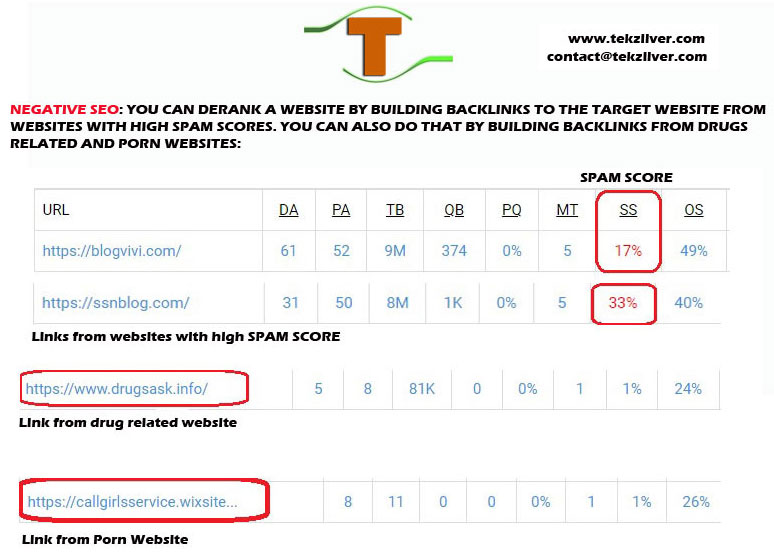
The idea is, you can de-rank a website on Google by creating backlinks to the target website from low quality websites that have a high spam score. You can also de-rank a website by creating backlinks to it from drugs related and porn websites as well, which we have highlighted in the image above. You can also destroy a website's Google ranking by creating backlinks to the target website from PBNs and comment luv websites. Take a look at the next image to understand how these crooks tried to pull down our website:
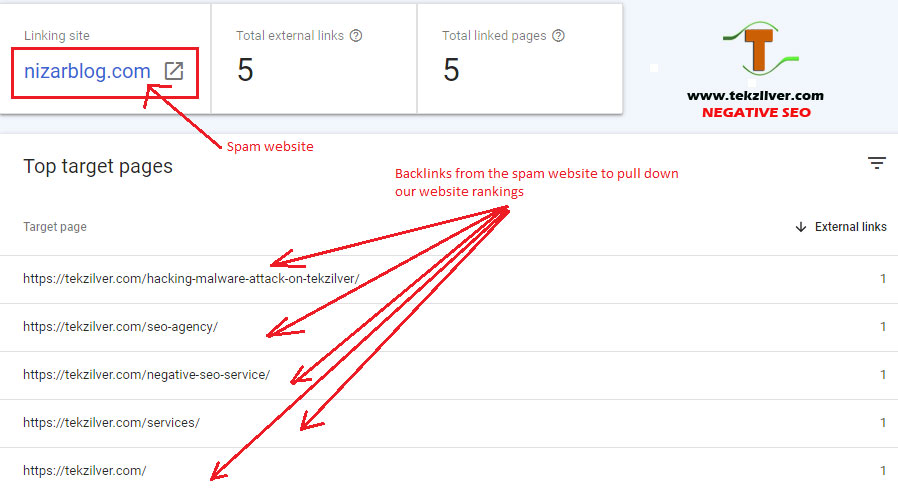
This type of attack could be a good idea for attacking relatively new websites and those that have a weak reputation and few backlinks. But it will not work on well-established websites, with a strong reputation and thousands of good backlinks. Further, all this can do some damage only as long as the website owner of the target website does not know about this or has not initiated any corrective measures. But if there is a strong monitoring process in place, such negative attacks will be mostly ineffective.
SAPE LINKS
SAPE (Search Advancement and Positioning Engine) links refer to a network of paid backlinks that were widely used in black hat SEO practices. SAPE links originated from a Russian link-building network called SAPE.ru. The network provided a platform where website owners could purchase links to artificially manipulate search engine rankings.
SAPE links are typically sold in bulk and offer a wide range of anchor texts, allowing buyers to optimize their backlink profiles for specific keywords. The links are placed on a network of websites that are often unrelated to the buyer's niche or industry. These websites are typically low-quality, with little or no editorial control, and their primary purpose is to host SAPE links.
The use of SAPE links is considered a black hat SEO technique because it involves manipulating search engine algorithms by purchasing links rather than earning them organically. Search engines, such as Google, actively discourage and penalize websites that engage in such practices, as they undermine the integrity of search results.
Using SAPE links or any other paid link schemes can result in severe penalties, including loss of search visibility, ranking drops, or even removal from search engine results. It is always recommended to focus on building high-quality, natural backlinks through ethical SEO practices, such as creating valuable content, engaging with your target audience, and earning links from reputable sources.
NICHE EDITS
Niche edits, also known as curated links or contextual links, are a technique used in SEO that involves placing backlinks within existing content on established websites within a specific niche. Unlike traditional link-building methods that involve creating new content or guest posting, niche edits involve adding links to already published articles or blog posts.
Niche edits can be used in manipulative ways to artificially boost search engine rankings. While niche edits can be usually procured by contacting the webmsters of the target websites, unscrupulous individuals can also inject these links using malware or other practices without obtaining permission from the webmster of the target website(s). Take a look at the image below.
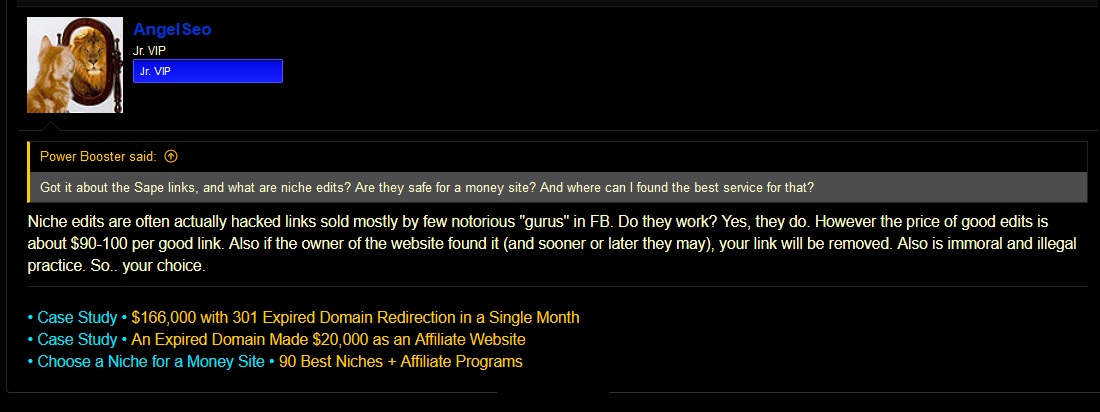
HOTLINKING
Hotlinking is the direct linking to the target website's content, particularly images or media files, from a different website. Instead of hosting the content on their own servers, cyber crooks embed these direct links on many spammy, low quality websites, causing the target website's server to bear the load of delivering that content. When users visit the malicious site and view the hotlinked content, it consumes the bandwidth of the target website, leading to increased hosting costs, slower server response times, and degraded user experience for legitimate visitors. Hotlinking is nothing but bandwidth theft, as the target website pays for the resources without actually using them, while the crooks enjoy the content delivery without paying for it. But these kind of attacks are elementary and can be easily blocked.
LIST OF NEGATIVE SEO SERVICE WEBSITES
We even found a bunch of websites that provided Negative SEO services. Take a look:
HOW TO REPORT SPAM, PAID LINKS, PHISHING AND MALWARE TO GOOGLE
As a web user, it is our responsibility to make the internet safe for everyone, including ourselves. Click here to report spam, paid links, phishing and malware to Google.
CONCLUSION
In conclusion, we tried to cover as much as possible about some of the important concepts of Negative-SEO, along with Black-Hat SEO and White-Hat SEO. The negative SEO stuff we wrote about here are all in addition to the other phishing, bruteforce and bot attacks that happen all the time, trying to identify vulnerabilities in your website(s). Having seen these attacks on our own websites for almost 2 years now, we have seen a pattern in these activities. These crooks mostly use commonly available VPNs and misuse VPS provided by various service providers to carry out their nefarious activities while also using the services of reputed service providers like Cloudflare to hide the identity of their own websites to save their own miserable skins. But fact is, when you're online, there's nowhere you can hide, especially if you're a crook!
We hope you found this useful. Please note, this article is published for information and educational purposes only. What you do with this information, is left to your own best judgement. There's an old Tamil saying, "If you beat the dog, be prepared to clean up the poop afterwards". That is, if you do what you're not supposed to, be prepared to face the consequences that follow.
Note: The images we used in this article feature the real faces of the bunch of low-life criminals who were caught in Nov 2021 running negative-seo attacks on Tekzilver and other websites owned by us. We filed a police complaint against these crooks with the cyber crime division of UP police and police investigation is in progress Surprisingly, two of these guys call themselves owners of a "technology first education company" in Noida called Digiversal Consultants and the other guy, in the middle is the owner of a web hosting service provider & reseller of OVH.ca. Criminals such as these have no place in any civilized society and should be rightfully locked up in jail.
Tekzilver.com is a global engineering design, cybersecurity, web services, digital marketing & SEO, content & training services provider. We leverage industry best practices to attain the highest levels of quality and customer satisfaction in our service deliverables
